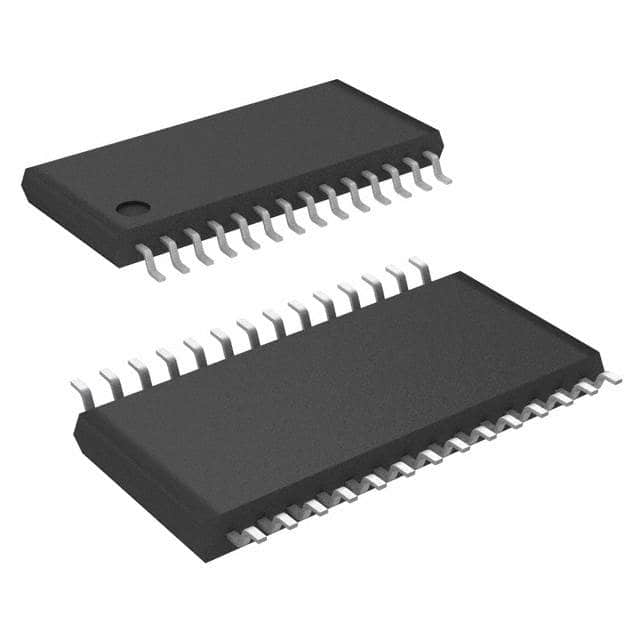Viz Specifikace pro podrobnosti o produktu.

AD7490BRU
Product Overview
- Category: Analog-to-Digital Converter (ADC)
- Use: Converts analog signals into digital data for processing and analysis
- Characteristics: High-resolution, low-power consumption, small form factor
- Package: 24-pin TSSOP (Thin Shrink Small Outline Package)
- Essence: Provides accurate and reliable conversion of analog signals to digital format
- Packaging/Quantity: Available in reels of 250 units
Specifications
- Resolution: 12 bits
- Sampling Rate: Up to 1 MSPS (Mega Samples Per Second)
- Input Voltage Range: 0V to VREF (Reference Voltage)
- Power Supply: 2.7V to 5.25V
- Operating Temperature Range: -40°C to +85°C
- Interface: Serial Peripheral Interface (SPI)
Pin Configuration
The AD7490BRU has a total of 24 pins, which are assigned specific functions as follows:
- VDD: Power supply voltage
- VREF: Reference voltage input
- AGND: Analog ground
- DGND: Digital ground
- SDI: Serial data input
- SDO: Serial data output
- SCLK: Serial clock input
- CS: Chip select input
- CONVST: Convert start input
- BUSY: Conversion status output 11-14. D[11:8]: Digital output pins (LSB to MSB) 15-24. AIN[11:0]: Analog input pins (LSB to MSB)
Functional Features
- High-resolution conversion: The AD7490BRU offers 12-bit resolution, ensuring accurate representation of analog signals.
- Low-power consumption: Designed with power-saving features, making it suitable for battery-powered applications.
- Small form factor: The compact TSSOP package allows for space-efficient integration into various electronic systems.
- Serial interface: Utilizes the SPI protocol for easy communication with microcontrollers and other digital devices.
Advantages and Disadvantages
Advantages
- High accuracy and precision in analog-to-digital conversion
- Low power consumption extends battery life in portable devices
- Compact size enables integration in space-constrained designs
- Simple serial interface facilitates easy integration with digital systems
Disadvantages
- Limited resolution compared to higher-end ADCs
- Requires an external reference voltage for accurate conversions
- May require additional circuitry for signal conditioning in certain applications
Working Principles
The AD7490BRU operates by sampling the analog input voltage and converting it into a corresponding digital value. It utilizes a successive approximation register (SAR) architecture, which compares the input voltage against a reference voltage and determines the digital output based on this comparison. The conversion process is controlled by the internal clock and can be initiated by a command from the microcontroller via the chip select (CS) pin.
Detailed Application Field Plans
The AD7490BRU finds application in various fields, including:
- Industrial Automation: Used for monitoring and control of analog signals in industrial processes.
- Medical Devices: Enables precise measurement and analysis of physiological signals in medical equipment.
- Test and Measurement Instruments: Provides accurate data acquisition capabilities for laboratory equipment.
- Communication Systems: Used in wireless communication systems for signal processing and modulation.
- Automotive Electronics: Enables analog signal conversion in automotive control systems and sensors.
Alternative Models
For users seeking alternative options, the following ADC models can be considered:
- AD7790: 24-bit resolution, low-power, sigma-delta ADC.
- ADS124S08: 24-bit, delta-sigma ADC with integrated PGA (Programmable Gain Amplifier).
- MCP3208: 12-bit, SPI interface ADC with 8 input channels.
These alternative models offer different features and specifications, allowing users to choose the most suitable ADC for their specific application requirements.
Word count: 529 words
Seznam 10 běžných otázek a odpovědí souvisejících s aplikací AD7490BRU v technických řešeních
Sure! Here are 10 common questions and answers related to the application of AD7490BRU in technical solutions:
Q: What is the AD7490BRU? A: The AD7490BRU is a 12-bit, successive approximation analog-to-digital converter (ADC) from Analog Devices.
Q: What is the resolution of the AD7490BRU? A: The AD7490BRU has a resolution of 12 bits, meaning it can represent analog input signals with 4096 discrete levels.
Q: What is the maximum sampling rate of the AD7490BRU? A: The AD7490BRU can sample at a maximum rate of 1 MSPS (Mega Samples Per Second).
Q: What is the supply voltage range for the AD7490BRU? A: The AD7490BRU operates with a supply voltage range of 2.7V to 5.25V.
Q: Does the AD7490BRU have an internal reference voltage? A: No, the AD7490BRU requires an external reference voltage for accurate conversions.
Q: What is the interface used by the AD7490BRU? A: The AD7490BRU uses a serial interface called Serial Peripheral Interface (SPI) for communication with microcontrollers or other devices.
Q: Can the AD7490BRU be used in single-ended or differential mode? A: Yes, the AD7490BRU supports both single-ended and differential input modes.
Q: What is the typical power consumption of the AD7490BRU? A: The AD7490BRU has a typical power consumption of 3.5 mW at 1 MSPS.
Q: Does the AD7490BRU have built-in digital filters? A: No, the AD7490BRU does not have built-in digital filters. External filtering may be required depending on the application.
Q: What is the temperature range for the AD7490BRU? A: The AD7490BRU can operate in a temperature range of -40°C to +85°C.
Please note that these answers are based on general information about the AD7490BRU and may vary depending on specific datasheet specifications or application requirements.

